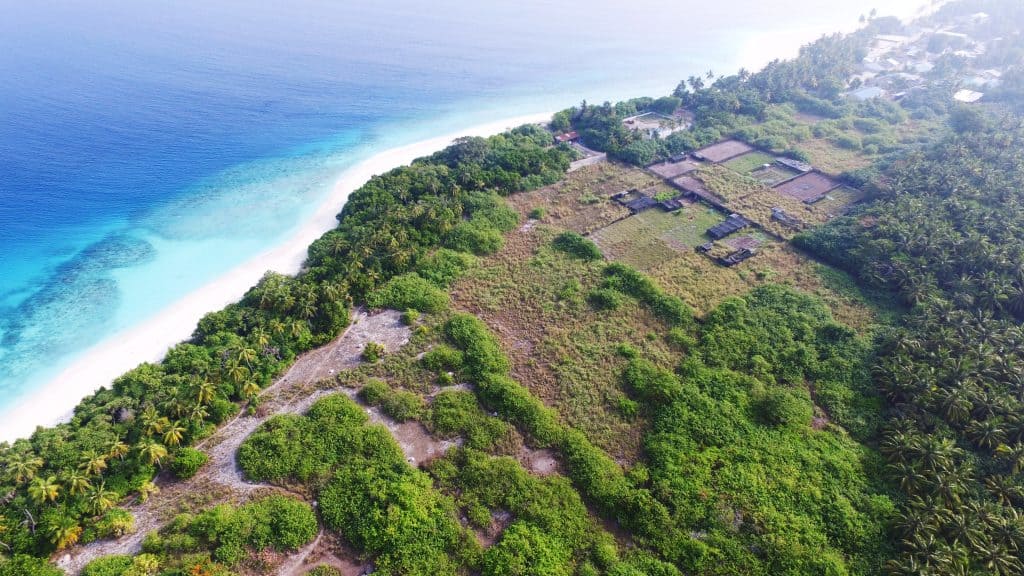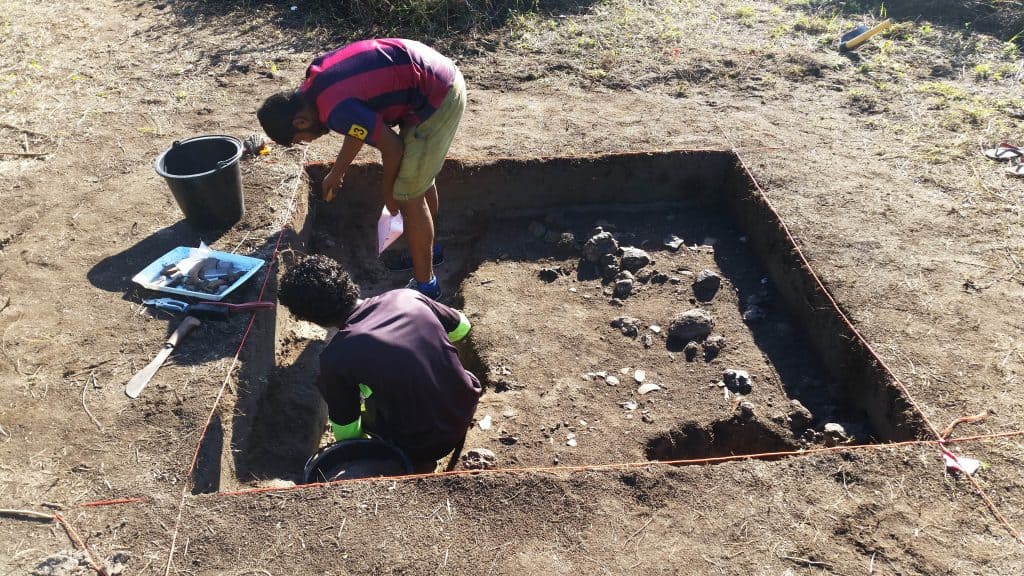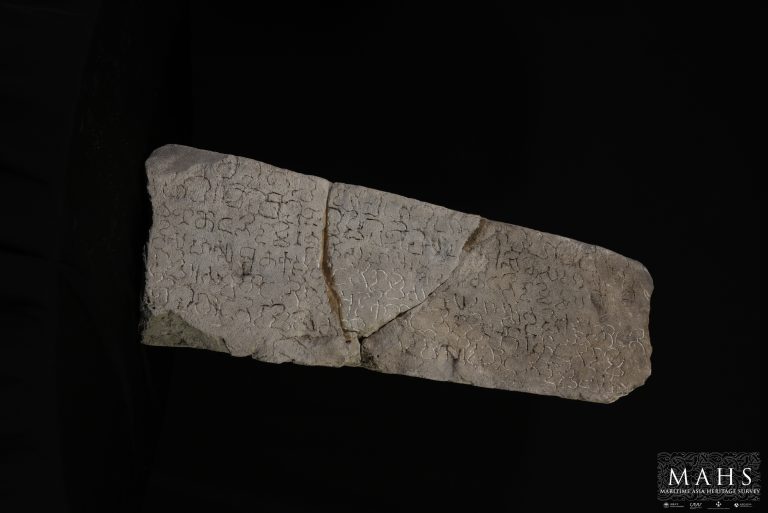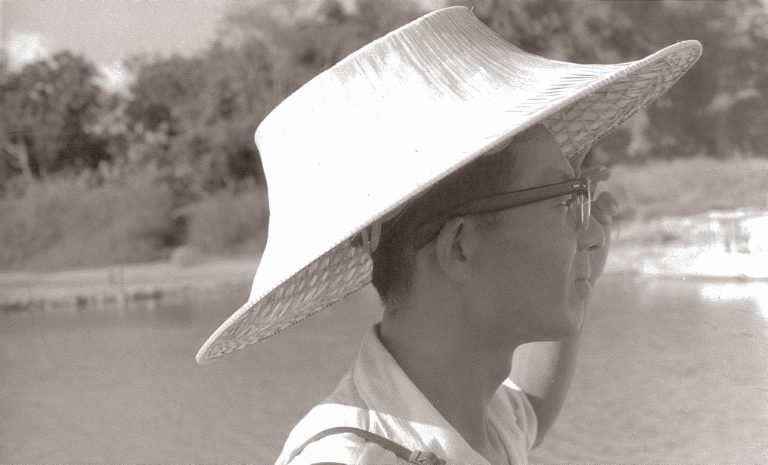AN ARCHEOLOGICAL INSIGHT INTO THE MEDIEVAL MALDIVES
The Indian Ocean archipelago of the Maldives has been connected to global networks for centuries; multiple medieval accounts mention the export of commodities such as coconut fibre, fish, ambergris, tortoise shell or water, and they link this active commercial role of the Maldives with their wider role within the Islamic world. One of the most famous accounts is that of Ibn Battuta who, in the fourteenth century, described the export of cowrie shells to India and West Africa and the use of Chinese ceramics in the households he visited. This account is particularly interesting to archaeologists for two reasons: Ibn Battuta mentions commodities that are archaeologically recoverable and names the island of Kinolhas, in Raa atoll, as one place at which he resided. Kinolhas was so distinguished that it attracted the world traveller’s attention and he referred to it as a fine island, with many mosques.
Figure 1. Kinolhas. The archaeological site lies in the foreground of this drone images, and the present-day settlement can be seen in the background
Despite the fact that that the medieval Islamic period was known to have been one of intense activity in the Maldives, hardly any archaeological work had examined this time. This was changed by research conducted by our team in the archipelago between 2013 and 2019. The book Archaeological Investigations of the Maldives in the Medieval Islamic Period; Ibn Battuta’s Island (soon to be published)[i] deals specifically with our archaeological survey and excavations at Kinolhas. We were able to identify or re-appraise locations of historical or archaeological importance on the island. We found an archaeological site on the border of the modern village and gardens (Figure 1), clarified its extent and confirmed that it lay undisturbed. We excavated seven units (Figure 2), all of which yielded archaeological material such as pottery, shell and bone, as well as a number of imported items: stone, glass and metal. Most sampled living areas: one at least cut through a midden and was extremely rich in pottery and animal bone. Another unit, the largest, revealed a shrine or mausoleum, surrounded by gravestones and rubble and broken pottery (Figure 3).
Figure 2. Kinolhas: excavation under way
This settlement and funerary site were radiocarbon dated to the fourteenth/fifteenth centuries, with both earlier and later components. The finds included items originating throughout the Indian Ocean world and beyond – from the Middle East to China. We uncovered vast amounts of pottery of likely Indian origin, mainly cooking pots and water jars; these were probably personal items, and they suggest the existence of long-distance trading communities of the sort that are evoked in written records. We also recovered ceramics of Chinese and South Asian origin which provide a preliminary map of fluctuating connections, as well as hundreds of cowrie shells, a compelling confirmation of the historical accounts. Further connections with other parts of the Indian Ocean network came through a shared third-party material culture, materialised by items such as glass bangles of the kind reported across the wider Indian Ocean region. We also showed that the Islamic period settlement is immediately adjacent to large-scale stone structures which appear to be of Buddhist affiliation. Present-day residents of Kinolhas retain a partial recollection of these remains and consider specific elements of the landscape – in particular, the presence of a Bodhi (Ficus religiosa) tree – to be evidence of past settlement. They also hold traditions about the accommodation of past Buddhist and Muslim communities.
Figure 3. Kinolhas: excavation of the funerary complex under way
As well as our excavation and survey work at Kinolhas we conducted work on three other islands and surveys on a dozen others. Those results, also reported in our forthcoming book, point to a broadly common archaeological signature for the medieval Islamic period in the Maldives. To this, we can add to the work carried out in the Maldives by the Maritime Asia Heritage Survey (MAHS) that offers a valuable horizontal dimension to these findings and suggests their considerably wider replicability. The scatters of artefacts and dismantled structures identified by the MAHS at Vaikaradhoo in Haa Dhaalu atoll[ii], for example, mirror our survey findings at Kinolhas. Also, we see the funerary structure we excavated as comparable to some of the ziyaarats (shrine mausolea) that we noted during our survey as well as those that have been extensively documented by MAHS. Similar observations can be said of the well that we excavated at Kinolhas (Figure 4).
This work helps bring to life an important part of the global medieval world and offers a valuable complement and corrective to the abundant historical sources that speak of the Maldives’ importance in past webs of connection.
Figure 4. Cultural heritage remains at Fainu. Left: Ziyaarat (shrine mausolea): 3.5x5m enclosure with 1.5x2m monument inside. The monument is 80cm tall and has a door and two windows, and a collapsed tin roof. Informants describe this as having been used in living memory, in relation to problems relating to pregnancies. It was renovated in the mid-1980s but is no longer in use. Right: Square well of coralstone, with traces of plaster visible on east face. 75x75cm in size, with water at about 1.5m below surface. Informants reported that people used to come even from neighbouring Kinolhas to collect water here (and indeed early charts drawn up by European visitors identify Fainu as an island providing good water), but usage ceased 20 years ago.
References:
[i] Anne Haour & Annalisa Christie, eds. Archaeological Investigations of the Maldives in the Medieval Islamic Period: Ibn Battuta’s Island. London: Routledge, (forthcoming 2022) – https://www.routledge.com/Archaeological-Investigations-of-the-Maldives-in-the-Medieval-Islamic-Period/Haour-Christie/p/book/9780367762698
[ii] R. Michael Feener, ed., Maritime Asia Heritage Survey (https://maritimeasiaheritage.cseas.kyoto-u.ac.jp/). https://arches.maritimeasiaheritage.cseas.kyoto-u.ac.jp/report/2a060558-e036-488c-b503-7707ec37d6ae clearly relates to an archaeological site dismantled by farming, while https://arches.maritimeasiaheritage.cseas.kyoto-u.ac.jp/report/c9f72a25-84c7-4c1a-9e89-52858781f656 shows a stone feature similar to those we encountered repeatedly at Kinolhas.








